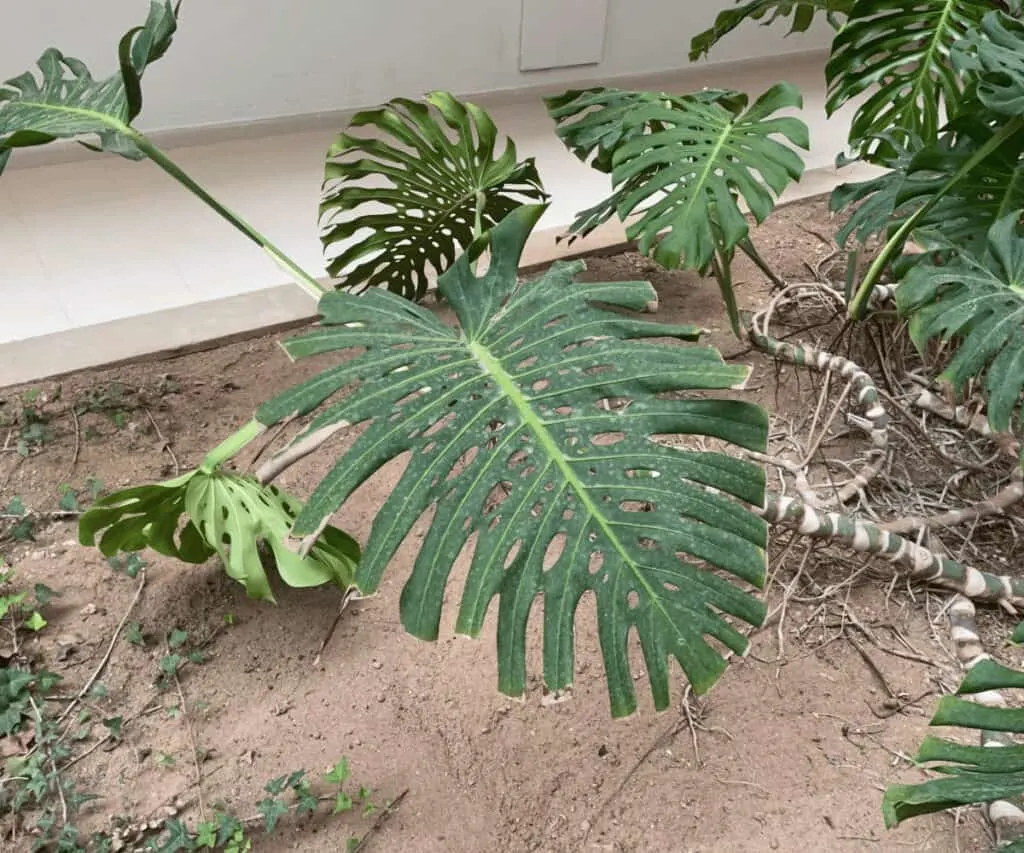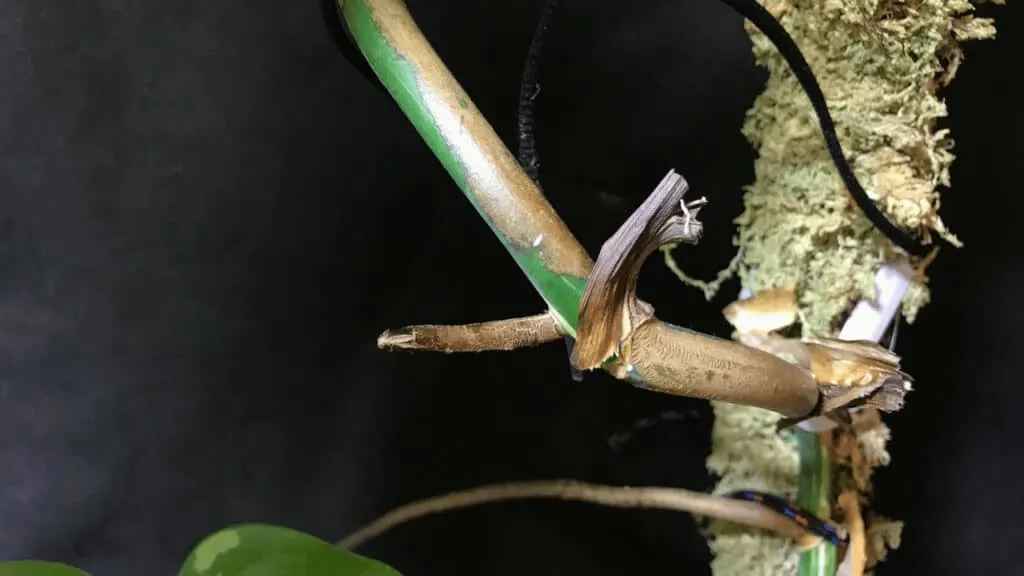Why does a Monstera have a brown stem? Monstera deliciosa is also termed the ‘Swiss-cheese plant.’ It is typically grown as a houseplant in regions that lie at mid-latitudes. The plant is a member of the Araceae family and can grow up to 65 feet (20 meters) in tropical forests. It is a flowering plant. You can eat Monstera deliciosa fruit.
With its lush green, large leaves, this tropical plant elevates the outlook of your garden. However, improper care and negligence can cause its stem to brown and wilt.
Table of Contents
Why Does My Monstera Deliciosa Have A Brown Stem?
The most likely chances are that your plant has undergone stem rot. Overwatering or improper drainage can cause the stem to brown and infect. Remove the plant from the pot to fix a stem rot, and wash the roots. Ensure your plant does not get waterlogged by watering it only when the topsoil appears dry. Though treatable early, stem rot can kill your plant if immediate actions are not taken. Not all brown parts on a stem are a bad sign. Stems become woody and appear brown. Furthermore, foliar shears are also brown, where a leaf emerged from your Monstera Deliciosa. This is normal, and no reason to worry.

How to Take Adequate Care Of Your Monstera Deliciosa Plant?
Monstera Deliciosa can prove to be a lovely addition to your home. But to sustain their mesmerizing appearance, adequate plant care is imperative.
Grow your Monstera Deliciosa plant in a room of 77 to 85 degrees Fahrenheit (25 to 30 degrees Celsius). Position the plant in an area with bright indirect light.
The most important thing to consider while planting Monstera Deliciosa is to avoid overwatering.
Make sure that your pot contains drainage holes. And, only water the plant when the roots have absorbed all water and they seem moisture-free. To ensure proper growth, fertilize your plant at least once a month.
Causes of Brown Stems on Monstera Deliciosa Plants
The most common causes for brown rotting stems on Monstera Deliciosa plants are listed below.

Overwatering
Monstera plants are prone to fungal diseases. Fungus likes to grow in wet places, so overwatering your plant can promote its growth.
Most people commonly follow a routine for watering their plants without testing the soil for its dryness. This causes the soil to become soggy and the stem to rot.
A better approach is to monitor the dryness of the soil closely. And water your Monstera plant only when the stem and topsoil seem almost completely dry.
Poor Drainage
As stated, you must plant your Monstera Deliciosa in a pot with drainage holes. This way, your soil will not get waterlogged.
Waterlogged soil leads to a shortage of oxygen for the plant. Insufficient oxygen levels and excess humidity induce the growth of pathogens like fungi and bacteria.
Poor Quality Soil Mix
If the soil mix is not properly drained, your stem will develop rot eventually. A low-quality soil mix has many pores that cause it to retain water for an extended period.
Thus, even if you are carefully watering your plant, stem rot cannot be avoided until the soil mixture is replaced.
Excessive Use of Fertilizer
Though fertilization is helpful for healthy plant growth, excessive use is harmful. Over-fertilizing the soil leads to a large amount of salt accumulation. The soil becomes saline and vulnerable to pathogen attacks.
It is recommended to fertilize your plant monthly during summer and spring.
Improper Temperature Conditions
Monstera Deliciosa requires an optimum temperature for proper growth. However, if the temperature drops very low, the soil stays moist for longer.
The soil eventually develops fungus, causing the stem to brown and rot.
How to Treat a Monstera Deliciosa Stem Rot?
Remove the plant from the soil as soon as you notice the color of your stem’s stem darkening. Place it below the tap, and wash the roots with soap water.
Clean the pot with a disinfectant, and fill it with a new soil mix.
There are specific ways to deal with a Monstera Deliciosa with stem rot. You must cover your hands with gloves and use tongs to wash the roots and stem.
Try to cut out all affected regions on the stem and leaves. You can do so by slicing the midrib and slowly moving toward the infected areas.
If you wait for the darkening to continue, the rot will spread. And your plant will die soon.
While washing the roots, handle them with care, as they are delicate. In addition to this, cut out the adventitious roots that are fully rotted. Once the roots have been properly washed and the pot rinsed, the plant is ready for regrowth.
However, ensuring that such a situation does not arise in the future is vital. To prevent stem rot from happening again, you must closely follow the soil’s moisture level.
There are several methods to know if your plant requires watering.
- Dig your index finger deep into the soil (just above the bottom root). If the soil is entirely moisture-free, then this is a sign for you to water it.
- Make use of a wooden stick. To keep your hands clean (and avoid any risk of getting a fungal infection on your fingers), you can probe the soil with a stick. You should not water your plant if your stick becomes moist after insertion.
- Buy a moisture meter. Technology has led to the development of more convenient methods for us. A moisture meter is a device that accurately measures the soil’s moisture level.
Tips To Avoid Browning of Stem
- Use a chunky soil mix
- Ensure that the stem is not buried by soil
- Strictly avoid overwatering the soil.
Frequently Asked Questions About Why Monstera Has A Brown Stem
How can I be sure that my Monstera Deliciosa plant stem is browning?
Usually, people confuse a light brown sheath on the stem with a fungal infection. If the color does not darken over time, then it is likely that the stem is just giving way to new leaves. There is no need to be concerned.
Will my Monstera Deliciosa plant grow back after cutting?
You can cut back a rotting stem. Make sure to remove all brown and mushy parts. As long as the main plant has nodes left, it will regrow.
Final words
The stem on the Monstera deliciosa browns as it matures. The woody section on the stem is normal. If the stem becomes mushy and soft, however, the brow parts of the stem indicate stem rot.

Daniel has been a plant enthusiast for over 20 years. He owns hundreds of houseplants and prepares for the chili growing seasons yearly with great anticipation. His favorite plants are plant species in the Araceae family, such as Monstera, Philodendron, and Anthurium. He also loves gardening and is growing hot peppers, tomatoes, and many more vegetables.


